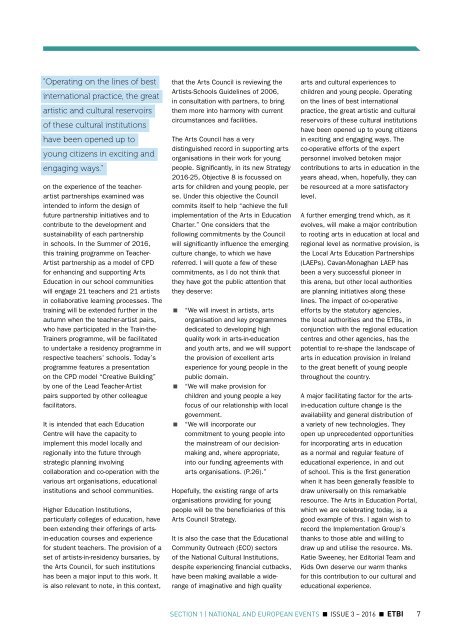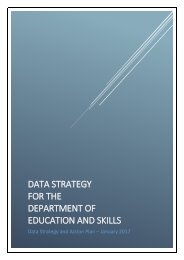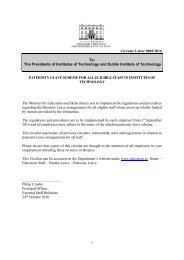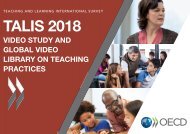ETBI-News-Summer-2016-web
ETBI-News-Summer-2016-web
ETBI-News-Summer-2016-web
Create successful ePaper yourself
Turn your PDF publications into a flip-book with our unique Google optimized e-Paper software.
"Operating on the lines of best<br />
international practice, the great<br />
artistic and cultural reservoirs<br />
of these cultural institutions<br />
have been opened up to<br />
young citizens in exciting and<br />
engaging ways."<br />
on the experience of the teacherartist<br />
partnerships examined was<br />
intended to inform the design of<br />
future partnership initiatives and to<br />
contribute to the development and<br />
sustainability of each partnership<br />
in schools. In the <strong>Summer</strong> of <strong>2016</strong>,<br />
this training programme on Teacher-<br />
Artist partnership as a model of CPD<br />
for enhancing and supporting Arts<br />
Education in our school communities<br />
will engage 21 teachers and 21 artists<br />
in collaborative learning processes. The<br />
training will be extended further in the<br />
autumn when the teacher-artist pairs,<br />
who have participated in the Train-the-<br />
Trainers programme, will be facilitated<br />
to undertake a residency programme in<br />
respective teachers’ schools. Today’s<br />
programme features a presentation<br />
on the CPD model “Creative Building”<br />
by one of the Lead Teacher-Artist<br />
pairs supported by other colleague<br />
facilitators.<br />
It is intended that each Education<br />
Centre will have the capacity to<br />
implement this model locally and<br />
regionally into the future through<br />
strategic planning involving<br />
collaboration and co-operation with the<br />
various art organisations, educational<br />
institutions and school communities.<br />
Higher Education Institutions,<br />
particularly colleges of education, have<br />
been extending their offerings of artsin-education<br />
courses and experience<br />
for student teachers. The provision of a<br />
set of artists-in-residency bursaries, by<br />
the Arts Council, for such institutions<br />
has been a major input to this work. It<br />
is also relevant to note, in this context,<br />
that the Arts Council is reviewing the<br />
Artists-Schools Guidelines of 2006,<br />
in consultation with partners, to bring<br />
them more into harmony with current<br />
circumstances and facilities.<br />
The Arts Council has a very<br />
distinguished record in supporting arts<br />
organisations in their work for young<br />
people. Significantly, in its new Strategy<br />
<strong>2016</strong>-25, Objective 8 is focussed on<br />
arts for children and young people, per<br />
se. Under this objective the Council<br />
commits itself to help “achieve the full<br />
implementation of the Arts in Education<br />
Charter.” One considers that the<br />
following commitments by the Council<br />
will significantly influence the emerging<br />
culture change, to which we have<br />
referred. I will quote a few of these<br />
commitments, as I do not think that<br />
they have got the public attention that<br />
they deserve:<br />
“We will invest in artists, arts<br />
organisation and key programmes<br />
dedicated to developing high<br />
quality work in arts-in-education<br />
and youth arts, and we will support<br />
the provision of excellent arts<br />
experience for young people in the<br />
public domain.<br />
“We will make provision for<br />
children and young people a key<br />
focus of our relationship with local<br />
government.<br />
“We will incorporate our<br />
commitment to young people into<br />
the mainstream of our decisionmaking<br />
and, where appropriate,<br />
into our funding agreements with<br />
arts organisations. (P.26).”<br />
Hopefully, the existing range of arts<br />
organisations providing for young<br />
people will be the beneficiaries of this<br />
Arts Council Strategy.<br />
It is also the case that the Educational<br />
Community Outreach (ECO) sectors<br />
of the National Cultural Institutions,<br />
despite experiencing financial cutbacks,<br />
have been making available a widerange<br />
of imaginative and high quality<br />
arts and cultural experiences to<br />
children and young people. Operating<br />
on the lines of best international<br />
practice, the great artistic and cultural<br />
reservoirs of these cultural institutions<br />
have been opened up to young citizens<br />
in exciting and engaging ways. The<br />
co-operative efforts of the expert<br />
personnel involved betoken major<br />
contributions to arts in education in the<br />
years ahead, when, hopefully, they can<br />
be resourced at a more satisfactory<br />
level.<br />
A further emerging trend which, as it<br />
evolves, will make a major contribution<br />
to rooting arts in education at local and<br />
regional level as normative provision, is<br />
the Local Arts Education Partnerships<br />
(LAEPs). Cavan-Monaghan LAEP has<br />
been a very successful pioneer in<br />
this arena, but other local authorities<br />
are planning initiatives along these<br />
lines. The impact of co-operative<br />
efforts by the statutory agencies,<br />
the local authorities and the ETBs, in<br />
conjunction with the regional education<br />
centres and other agencies, has the<br />
potential to re-shape the landscape of<br />
arts in education provision in Ireland<br />
to the great benefit of young people<br />
throughout the country.<br />
A major facilitating factor for the artsin-education<br />
culture change is the<br />
availability and general distribution of<br />
a variety of new technologies. They<br />
open up unprecedented opportunities<br />
for incorporating arts in education<br />
as a normal and regular feature of<br />
educational experience, in and out<br />
of school. This is the first generation<br />
when it has been generally feasible to<br />
draw universally on this remarkable<br />
resource. The Arts in Education Portal,<br />
which we are celebrating today, is a<br />
good example of this. I again wish to<br />
record the Implementation Group’s<br />
thanks to those able and willing to<br />
draw up and utilise the resource. Ms.<br />
Katie Sweeney, her Editorial Team and<br />
Kids Own deserve our warm thanks<br />
for this contribution to our cultural and<br />
educational experience.<br />
Section 1 | National and European Events issue 3 – <strong>2016</strong> <strong>ETBI</strong> 7





